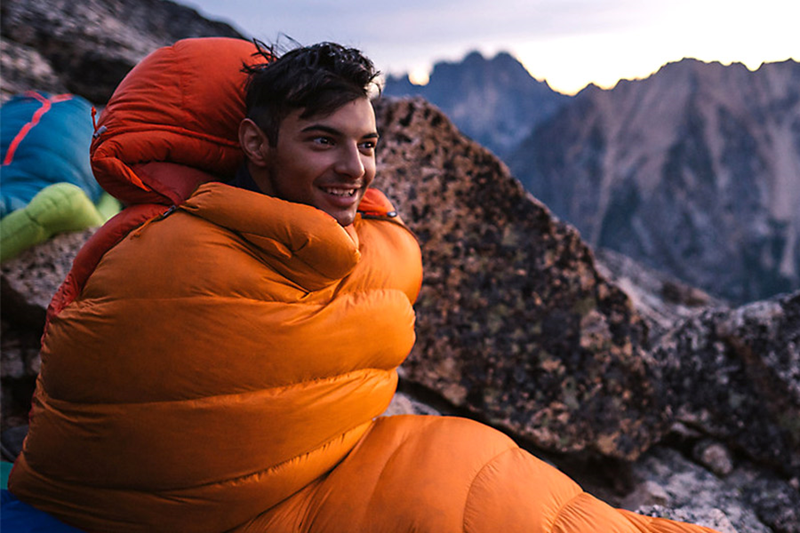Cold, wet, easy to get stuck, and harder to start a wood campfire, winter camping isn’t for the faint-hearted. But once you brave the cold, nature reveals its wildest beauty and peaceful solitude that’s hard to find in other seasons. To enjoy this raw, untouched wilderness, staying warm, especially at night, is essential. After all, you want to feel the thrill, not the chill.
With proper gear like a sleeping bag, four-weather tent, and blanket, you can enjoy the peaceful stillness of a winter night in comfort and warmth.
Sleeping Bag
Insulation
The insulation or fill is everything when choosing a winter sleeping bag. Aside from thickness, the type of insulation matters too. Will you choose the lightweight warmth of a down hiking sleeping bag, or maybe opt for the moisture-resistant reliability of synthetic insulation? It depends on how and where you’ll be using it.
A down hiking sleeping bag is filled with the soft, fluffy undercoating found beneath the tougher exterior feathers of ducks or geese, known as down clusters. These clusters trap air and create insulating pockets, making down an excellent natural insulator.
It provides an impressive warmth-to-weight ratio, meaning the material offers a lot of warmth without adding much bulk or heaviness. This makes it the perfect choice for activities like hiking or backpacking where every gram counts. Also, it won’t lose its shape no matter how much you compress it.
Just remember not to get this fabric wet because it will lose its insulating qualities. The main downside of down insulation is its poor performance when wet. When down gets wet, the fluffy clusters clump together, losing their ability to trap air and provide warmth. This can leave you feeling cold, especially in damp or rainy conditions.
However, many modern down bags use hydrophobic down or water-repellent shell fabrics to help the down resist moisture, which is its main weakness. Although they can be on the pricey side they’re an investment worth making.
Synthetic sleeping bags can provide just as much warmth as down options of the same temperature rating. But they weigh a lot more, making them bulkier and heavier to carry around. Therefore, if you’re hiking to the campsite, a synthetic sleeping bag might not be the best choice.
Shape
Sleeping bags also come in several shapes. The mummy shape is probably the most suitable choice for winter camping. Thanks to its design it hugs your body, reducing empty air space that needs to be heated. On the downside, it’s smaller, so it can be a bit claustrophobic and you may take some time to get used to it.
Rectangular ones, on the other hand, aren’t very suitable for winter conditions because they’re not tapered at the legs. Semi-rectangular sleeping bags strike the perfect balance between comfort and warmth. They offer more room around the shoulders and knees than a mummy bag but still retain heat better than a rectangular shape.
Tent
When it comes to col-weather camping, a regular tent just won’t cut it. Winter brings heavy snow and freezing temperatures that demand equipment built for the challenge. 4-weather tents, for instance, are designed to handle these extreme conditions. They offer durability, insulation, and stability when it matters most. 3-season tents are also suitable for winter camping, just not in heavy storms and snowfalls. They’re better for strong winds and heavy rain.
The shape of your tent is also important when camping in winter. A dome-shaped winter tent is one of the most suitable choices. Thanks to its curved shape it distributes wind and snow loads more evenly, bringing stability and resistance and it can stand up to the winds and snow better than
Cabin-shaped tents are more prone to collapsing under heavy snow or strong gusts but provide more usable space, making them great for group camping or extended stays. Camping in the winter means more equipment, blankets, ice axes, coats and warm clothing. This means you’ll need a bigger tent to fit everything inside. However, a bigger tent is harder to set up in the snow, so you have to find the right balance between size and shape.
The tent’s colour is probably not something you worry about in most conditions, but in winter camping, it truly matters. Opting for a brightly coloured tent makes it easier to spot in snowy conditions or during a snowstorm, enhancing visibility and safety.
Blanket
Even with a snow tent and a quality sleeping bag, you might also need a reliable blanket for an extra layer of warmth. Choose one with good insulation that traps heat and guards against hypothermia. The blanket’s material can make a big difference. Wool, for instance, is a natural fibre that remains insulating even when damp, thanks to its moisture-wicking abilities. Plus, it’s naturally fire-resistant, making it a smart choice for camping.
Polyester is another great option because it’s fire-resistant, waterproof, durable, and lightweight. Fleece is also a solid alternative, offering lightweight warmth, quick-drying capabilities, and reliable insulation, perfect for keeping cosy during cold-weather camping.